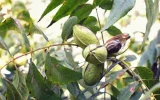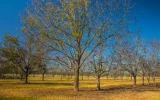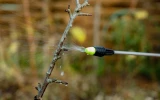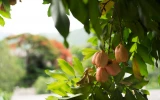How Many Pecan Trees Should You Plant per Acre?
If you're planning to start a pecan farm, one of the most important decisions you'll need to make is how many trees to plant per acre. Finding the right balance is key to maximizing your returns and ensuring a successful harvest. In this article, we'll explore the factors that affect the optimal number of pecan trees per acre.
You can plant pecan trees in densities of 12–48 trees per acre, with 50–60 trees per acre as a recommendation. The density will depend on factors like tree size, variety, and growth expectations. As you plan your pecan farm, consider good spacing between trees for proper growth and optimal production.
A typical spacing plan is a 40-foot by 40-foot grid, or 27 trees per acre. But other farmers are now planting pecans in smaller spaces, such as 20 feet by 40 feet, 30 feet by 30, or 20 feet by 30 feet. Let's find out how.
Summary
- Planting too few pecan trees can limit your potential profits, while planting too many can result in overcrowding and reduced yields.
- Your desired tree density will depend on factors like tree size, variety, and growth expectations.
- For standard size trees, use a 60-by-60-foot spacing, which allows for 12 trees per acre.
- For smaller trees, consider a 40-by-40-foot spacing, leading to 27 trees per acre.
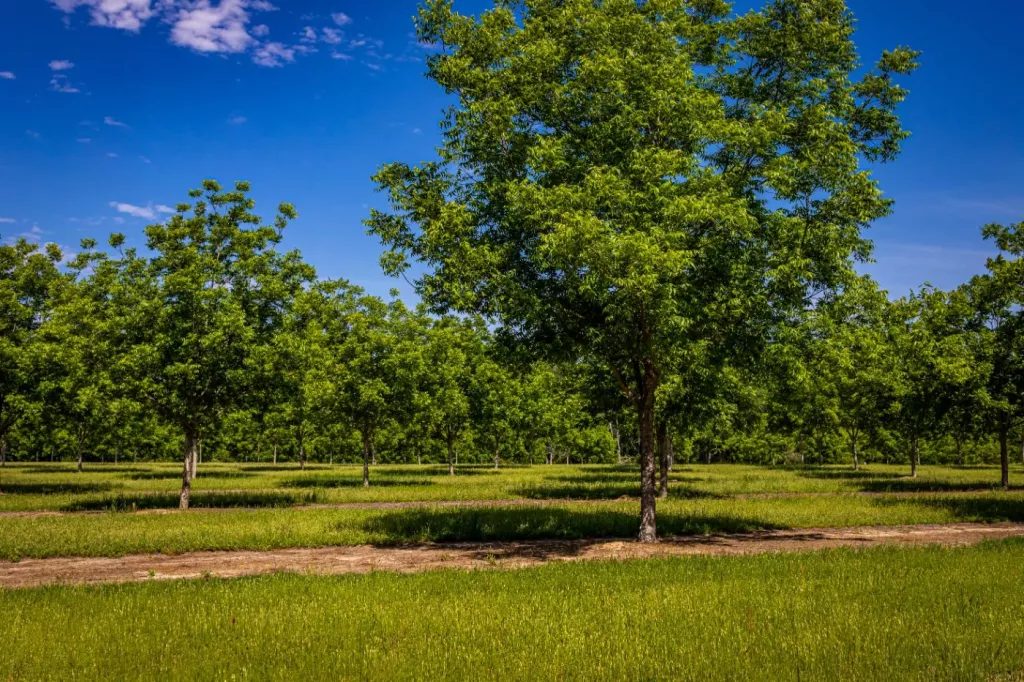
On this page:
The Ideal Planting Density for Pecan Trees
When planning your pecan orchard, it's essential to determine the ideal planting density to maximize both tree health and crop yield. In this section, we'll discuss spacing requirements and factors that influence the optimal number of pecan trees to plant per acre.
Spacing requirements for proper growth and production
Typically, 50–60 pecan trees can be planted on each acre, but the actual number can vary depending on the size of the trees and the desired spacing. To achieve a healthy and productive pecan orchard, you should consider the following spacing recommendations:
- For standard size trees, use a 60-by-60-foot spacing, which allows for 12 trees per acre.
- For smaller trees, consider a 40-by-40-foot spacing, leading to 27 trees per acre.
Always follow the specific recommendations for the variety of pecan trees you plan to plant, as their spacing needs might differ.
Factors influencing density of pecan trees to plant per acre
-
Soil Conditions: Pecan trees thrive best in deep, fertile, and well-drained soils with good water holding capacity. Ensure your planting site meets these requirements before deciding on tree density.
-
Irrigation: Water is essential to pecan tree growth, with mature trees requiring as much as 350 gallons of water per day during the nut filling stage. If your site cannot provide adequate irrigation, you may need to reduce the number of trees per acre.
-
Maintenance: Planting a higher density of pecan trees may result in higher yields, but it also increases maintenance requirements, such as pruning and pest control. Make sure you have the resources and expertise needed to manage a densely planted orchard.
Pecan Varieties and Their Impact on Spacing
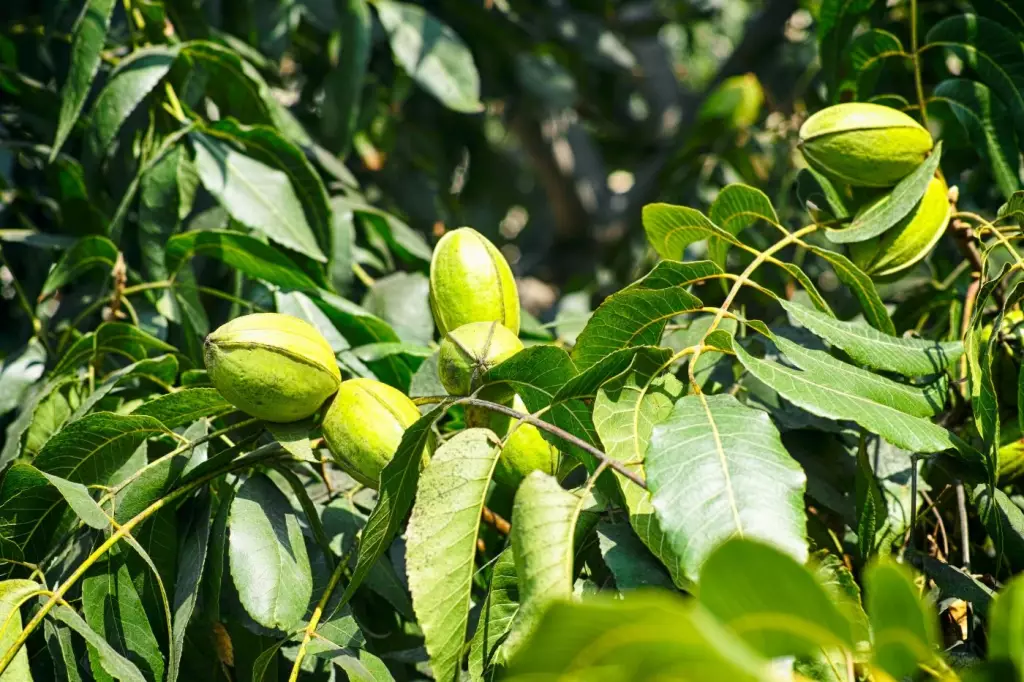
Type A and type B varieties of pecan tree
These varieties differ in their pollination habits, and this should be taken into account when planning your orchard's layout. Type A varieties shed pollen before their female flowers are receptive, while Type B varieties shed pollen after their female flowers are receptive. Mixing both types in your orchard can help ensure proper pollination and yield.
To maximize pollination efficiency, aim to plant equal numbers of Type A and Type B trees. You may also want to consult a pecan specialist to help you make your variety choices, as they can advise on the specific varieties best suited to your region.
Size of mature pecan tree impact the spacing required
Generally, pecan trees require enough space for proper growth and production. A common spacing pattern is a 40-foot by 40-foot grid, which equates to 27 trees per acre. However, some growers are now planting pecans in tighter configurations, such as 20 feet by 40 feet, 30 feet by 30 feet, or 20 feet by 30 feet.
Factors to consider when determining the proper spacing for your trees include:
- The specific varieties you are planting
- Your region's growing conditions
- Your orchard management practices
Proper spacing and management are critical for developing healthy and productive pecan orchards. It might be advisable to consult an expert to help you decide on the best spacing for your specific orchard and pecan tree varieties.
Soil and Site Considerations for Optimal Growth
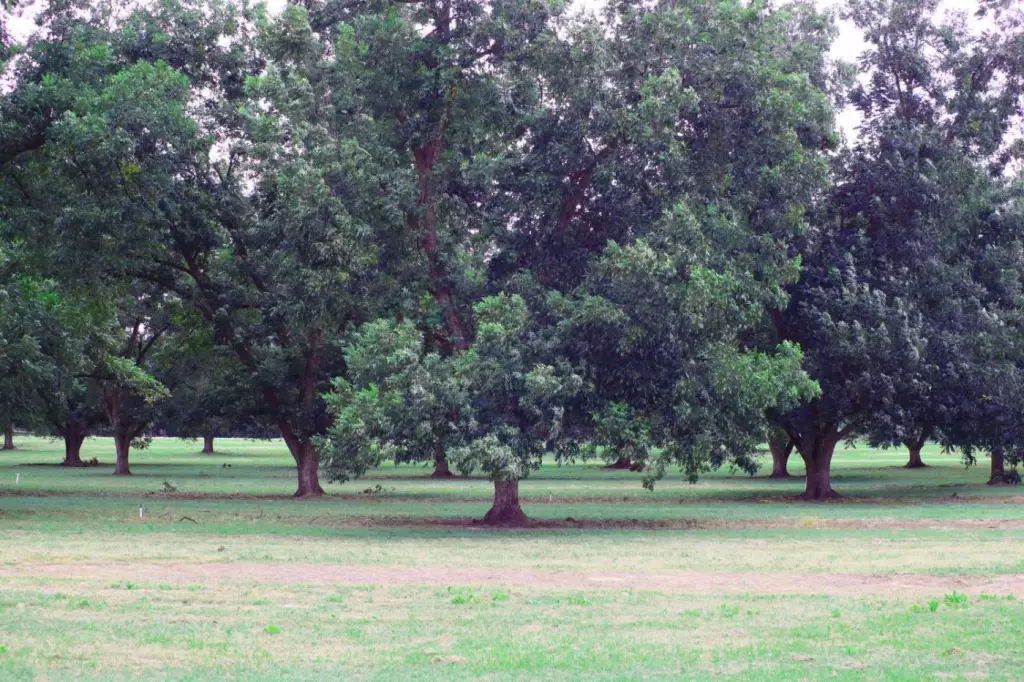
Soil types and drainage for pecan trees
Pecan trees prefer deep, fertile, and well-drained soil for ideal growth and production. Sandy loam soils with a clay subsoil are best, offering good water retention while still allowing for proper drainage. The soil pH should be between 6.0 and 7.0, as they like neutral to slightly acidic soils. When selecting a site for your pecan trees, make sure that the soil meets these requirements for optimal growth and production.
To improve your soil drainage, consider:
- Adding organic matter, such as compost, to increase water retention and drainage.
- Amending the existing soil with sand or well-rotted leaves, which can improve the soil structure and drainage capabilities.
Sunlight exposure and microclimate for pecans
For healthy growth and high nut yields, pecan trees require 6 to 8 hours of direct sunlight per day. Therefore, it's crucial to choose a site for your pecan trees with enough sunlight exposure throughout the growing season. Avoid planting your pecan trees near tall structures or other trees, as they may compete for sunlight and reduce yields.
In addition to sunlight requirements, consider the microclimate in the area where you plan to plant your pecan trees. Factors such as temperature, wind, and humidity can significantly affect the health and productivity of your pecan trees. For the best results, select a site with consistent temperatures and moderate humidity. If possible, choose a location that is protected from strong winds, as high winds can cause tree damage and reduce fruit set.
Pecan Tree Planting and Management
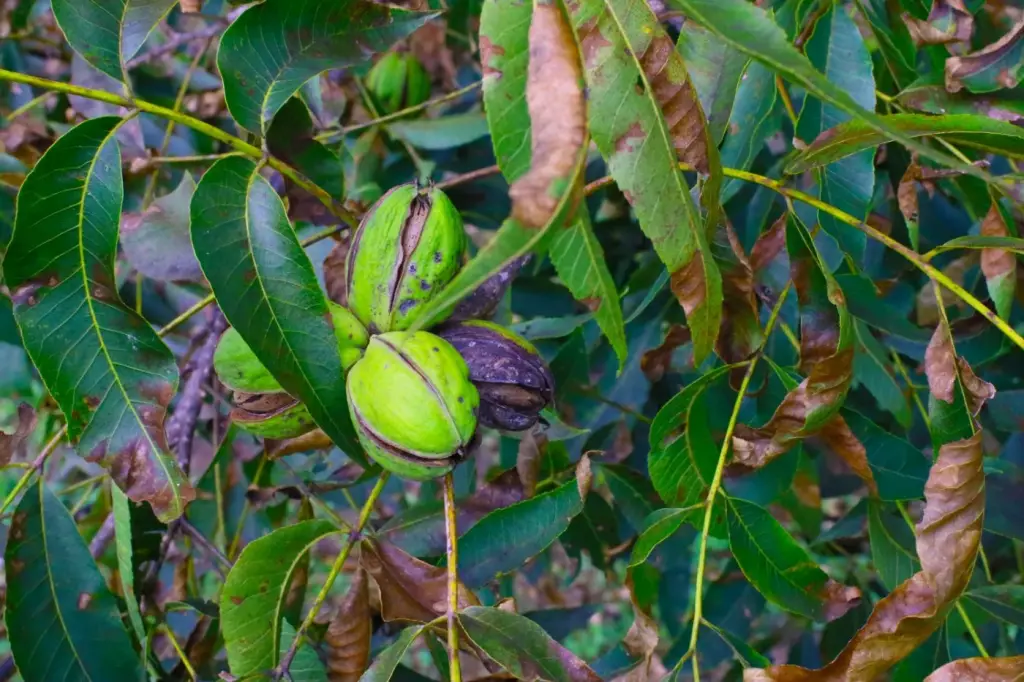
Planting techniques for your pecan trees
To ensure the best growth and production, you should plant your pecan trees in full sun, with at least 6 to 8 hours of sunlight per day. Pecan trees produce best in sandy loam with clay subsoil, so make sure the soil is fertile, well-drained, and still able to hold water.
A typical planting density for pecan trees ranges from 12 to 48 trees per acre, but it might vary depending on your location and specific planting conditions. It is important to consider the long taproot of pecan trees, which can be negatively affected by overly wet or soggy soil. Planting on a hilltop can help prevent drainage issues and create a visually striking landscape.
Pruning and thinning of your pecan trees for their health and productivity
Begin by removing weak or low-hanging branches. This would allow for better air circulation and sunlight penetration, reducing the risks linked to diseases and pest infestations. Removing excess branches also helps distribute nutrients more efficiently, aiding in overall tree growth and nut production.
In addition to pruning individual branches, consider thinning the total number of trees on your acre over time as they grow and their canopies widen. Thinning will help prevent overcrowding and provide more space for the remaining trees to expand and produce optimally.
